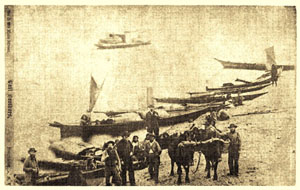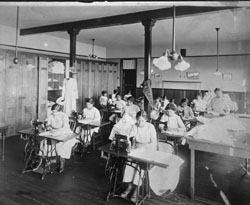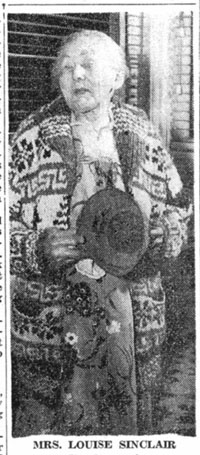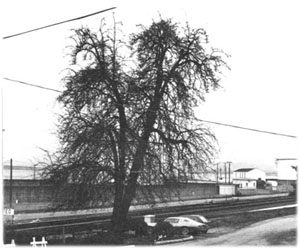 By David Cameron
By David Cameron
One of the most valuable contributions of the Depression-era Works Projects Administration (WPA) was a program of interviewing pioneers and their descendants throughout Washington State. With high unemployment among writers and the passing away of most of the “original” settlers, the idea was a natural and enlightened one. Out of it came several small books from the Secretary of State’s office entitled Told by the Pioneers*. Among several of the interviews concerning Snohomish County was one with Louisa Fowler Sinclair.
Louisa was the first settler child born in the county, followed shortly after by the second, Neil Spithill. Both were of mixed Native American/white ancestry. In 1860, Louisa’s father, Jacob D. Fowler, a native New Yorker, and her mother, Mary, moved to the site of Mukilteo to operate the county’s first store, saloon, hotel and post office. Only 24 at the time of the first county census in 1861, Fowler held office also as the county’s first auditor, and then treasurer when Mukilteo served as the first county seat before its backers were outvoted 17-10 by the supporters of Emory C. Ferguson and Snohomish on July 8, 1861.
Louisa was born the following year and retained vivid memories of her childhood. Those provide us with an invaluable glimpse of life in Snohomish County a century and a half ago. Here is her account:
“This early picture of J.D. Fowler and his team of oxen was found in one of the Fowler diaries. Fowler recorded many historical facts of early Mukilteo in the daily record he kept. The diaries have been handed down to his granddaughter, Frances Record…” From booklet entitled “History of Mukilteo”. “I was the first child born of a white parent in what is now Snohomish County. My father had operated a trading post and tavern at Ebey’s Landing on Whidby (sic) Island, and there had married my mother, who ran away from her parents of the Skagit tribe because she did not want to marry a brave they had chosen for her. She made her way across the Skagit prairie and somehow reached the northern end of Whidby (sic), and followed the shore line to Ebey’s Landing, where my father first employed her to help in the tavern.
“After they were married, my father joined with Mr. [Morris] H. Frost in establishing a trading post at Point Elliot (now known as Mukilteo). My first recollections of life are as a small girl playing along the beach, picking up bright pebbles there, and being entertained by Indians and now and then a white man at father’s store.
Mukilteo is mispronounced by almost everybody. It should be called ‘mew-kill-too’- meaning ‘good camping ground.’ Because it was a good camping ground, and because there was a trading post there, it became a popular place for many tribes to foregather, and very often there were Indians camped there from a dozen tribes. This led to frequent clashes among the tribesmen – and so many murders that the killing of one Indian by another became a commonplace. My father often used to say when he heard of another such killing, ‘Well, that’s fine – we’ll have Indian for breakfast, tomorrow!’ All the trouble, however, was between the Indians, they never attacked the white men, probably because all white men carried one or two big revolvers and a knife or two in their belts.

“When yet quite small, my parents decided I needed schooling and sent me to the Indian mission at Tulalip. But I did not like it there. I felt superior to the full-blooded Indians, and I did not like the service. We were fed good enough food, but it was served in tin plates and tin cups. These, after having been accustomed, in father’s house, to china, rough and heavy though it had been, was too primitive for me, and I rebelled. I went on a hunger strike, refusing to eat anything, and in desperation the mission returned me to my parents at Mukilteo. Later I went to school for a few terms at Snohomish, and there I worked for Mrs. Ferguson for my board.
“Perhaps I am incompetent to tell you much about the typical life of children in those days, for mine was not typical. I always boast that for years I was the most popular girl in Mukilteo – and I was, for there were no others. Therefore I was somewhat petted and spoiled, and as my associates were all adults, I was more than a little precocious.
“My mother early taught me the use of the needle, and I obtained patterns for shirts and other garments for men. From father’s store I got materials, and made shirts for sale. I was well paid for them. Too, I liked to pick up shells and colored pebbles, and make knickknacks and picture frames by embedding the bright-colored shells and pebbles in putty. These I sold for good prices. And when, somehow, I became possessed of a jig-saw, I spent a lot of time making seine needles, which were much in demand among the fishermen.
“I always had money, though I had little use for it. I suspect I was a bright youngster, for one day several men were sitting on the porch in front of father’s store watching the approach from the Sound of a sailing vessel which had appeared between the islands some miles away. They were betting as to which of the several vessels plying the Sound this might be. It seemed a good chance for me to make some more money. The vessel was too far away to be recognized, so I went into father’s store, got his binocular and slipped away to a place where I could watch it unseen. In a short time I saw the name. Then I replaced the binocular and very innocently joined the gamblers. They were still wondering. I said, ‘Can I bet?’ ‘Sure,’ they replied. ‘Well,’ I said, ‘I’ll bet it’s the “Walter Ellis”. I’ll bet five dollars.’
“Just for a joke, as they believed, they took the bet, and I produced my money. I won, of course. I didn’t tell how for years afterward.

“I often took care of the store while father was away on a trading trip. He would load up a boat, a small schooner, with flour and bright-colored cloth, and many small articles for trade, sail up Port Gardner Bay to the mouth of the Snohomish River and then up river as far as he could navigate. He would exchange his cargo for hides and cranberries, which upon his return he would ship to Tacoma. Most of his trading was with Indians, there were few white men along the Snohomish at that time.”
“One day while I was running the store, an Indian was knocked into a campfire during a fight near the store. His back was badly burned and he was in great pain. I wanted to help him and ran into the store to return with a bottle of Pain Killer, a liniment presumed to be good for
“My father was the first postmaster at Mukilteo, and in the early days there was no other post office in Snohomish County. So all the mail for settlers up the river came to our office. There may have been a schedule, but if there were, it didn’t mean much; for the mail often was a week later than we hoped for. Sometimes letters addressed to settlers up river lay in our office for weeks before being called for. But when a vessel called the ‘Chehalis’ began making regular trips up the Snohomish river, its captain used to pick up mail for settlers he knew and carry it to the nearest point he could reach”.

The Fowler Family is gone now, but the pear tree planted by them probably the year after Louisa was born in 1862 still remains at the foot of Park Avenue just above the railroad tracks cutting the street off from the waterfront. On a recent spring day it was blooming well, although the broken trunk is only a portion of the original tree. A Mukilteo maintenance worker from the shop across the street noted its pears are smaller than an orange and ripen slowly: “Probably a winter pear,” he observed. Crows and the public still harvest them, providing an ongoing continuity with our past. When it finally dies, the city plans on replacing the tree from cuttings taken six years ago and being raised by an arborist on Whidbey Island.
Mukilteo pioneer Jacob D. Fowler had some of his claim under cultivation as early as 1861 and it is believed his orchard was planted about 1863. Growing on the west side of his homestead, the Fowler pear tree remains as the sole survivor of that orchard.
©2006 David A. Cameron, All Rights Reserved
For more of the story including information on canning salmon, using dogfish oil lamps, trading feathers for pillows and bed ticks as well as hunting brant geese, see *Sinclair, Louise [Fowler] Told By the Pioneers: Tales of a Frontier Life As Told by Those Who Remember the Days of the Territory and Early Statehood of Washington , Volume II (Olympia, 1937-38), p. 179 – United States Works Progress Administration (Wash.)
